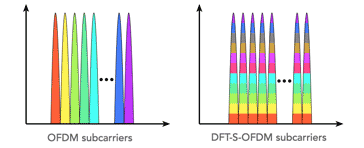DFT-S-OFDM Explained
DFT-S-OFDM is a form of orthogonal frequency division multiplexing used in advanced wireless systems to reduce the PAPR, enabling power amplifiers to operate more efficiently.
OFDM Orthogonal Frequency Division Multiplexing Includes:
OFDM basics
OFDM synchronisation
CP-OFDM
DFT-S-OFDM
See also:
Multicarrier modulation basics
What is FBMC
DFT-S-OFDM or Discrete Fourier Transform Spread Orthogonal Frequency Division Multiplexing) is a type of digital waveform that can be used for transmitting data over a wide RF channel.
The technology is actually a combination of two different technologies, namely, Discrete Fourier Transform (DFT) and Orthogonal Frequency Division Multiplexing (OFDM).
DFT-S-OFDM background
DFT-S-OFMDM builds on the basic OFDM principles. The basic idea behind OFDM is to divide the available frequency spectrum into multiple subcarriers, each of which is orthogonal to the others. This allows multiple users to transmit data simultaneously over the same frequency band without interfering with each other.
However, the disadvantage of basic OFDM is that it has a high peak to average power ratio, and unless technologies like envelope tracking or Doherty amplifiers are used, this can result in poor power amplifier efficiency levels.
The poor efficient arises because the power amplifier needs to run in a state where it can accommodate the peaks, even when lower signal levels are being transmitted.
The inefficiency not only increases power costs, especially for high power installations, but for mobile phones, etc it results in shorter battery life as much power is wasted.
Essentially, DFT-S-OFDM is a variant or development of OFDM that uses a spreading techniques based around a DFT matrix. It provides several advantages over OFDM, especially for various forms of wireless communication.
Advantages of DFT-S-OFDM:
Reduced peak to average power ratio, PAPR: DFT-S-OFDM is able to achieve its improved PAPR by distributing the signal energy across multiple subcarriers. The way in which this is done means that the peak power levels are reduced.
Reduced complexity compared to other methods: Using various forms of digital signal processing, DFT-S-OFDM is less complicated to implement when compared to using a Doherty amplifier which is notoriously difficult to design), envelope tracking or other PAPR reduction techniques.
These advantages mean that DFT-S-OFDM is a very useful option in a variety of situations for radio communications data links, where the improved PAPR can provide significant benefits.
DFT-S-OFDM principles
As the name indicates, DFT-S-OFDM is based around the basic concepts of OFDM, building on them to improve the level of spectrum usage efficiency and also enabling a reduction on the peak to average power ratio, often by about 3dB or more.
The basic concept of OFDM is that is uses a large number of close spaced carriers separated by a frequency equal to the reciprocal of the bit rate. This enables the sidebands and hence interference from the various carriers not to cause interference with the others.

The DFT version of the waveform spreads the data symbols in the frequency domain using a DFT matrix. The concept is to convert the data symbols into the frequency domain using a discrete Fourier transform. The frequency domain symbols that are obtained are then spread across the subcarriers.
To explain this a little further, the DFT matrix is an N x N matrix, where N is the number of OFDM subcarriers. Each row of the matrix corresponds to a particular subcarrier, and each column corresponds to a particular frequency component of the signal.
The spreading process for the data symbols, requires the DFT matrix to be multiplied by the frequency-domain symbols. This results in a time-domain signal that is spread across multiple subcarriers.

This signal can then be transmitted in the same way as a traditional OFDM signal, except for the fact that it has a lower PAPR.
The receiver process is essentially the reverse of the transmitter. First, the signal is demodulated using an OFDM demodulator to recover the frequency-domain symbols.
Next, the demodulated data is multiplied multiplied by the DFT matrix to reverse the spreading process and recover the original data.
One of the disadvantages of DFT-S-OFDM is that in spreading the signal over the carriers, it increases the bandwidth occupied, although there is a decrease int he overall PAPR.
When designing a radio communications system using OFDM, and there is the possibility of using DFT-S-OFDM, then a balance needs to be made between data throughput and bandwidth against the PAPR. Often systems will use DFT-S-OFDM when the lower PAPR is required and revert to OFDM when data throughput or bandwidth is the primary consideration.
DFT-S-OFDM applications
DFT-S-OFDM is used in a number of wireless applications where it gives improvements over the previous, more basic implementation of OFDM.
5G mobile phone networks: DFT-S-OFDM is used as an option in in the 5G New Radio in the uplink transmissions because of its improved PAPR when compared to the implementations of OFDM that would otherwise be used.
Digital broadcasting: Another use is for digital broadcasting where it has been incorporated into the DAB digital radio and DVB television standards.
Power-line communications: DFT-S-OFDM lends itself to use in power line communications used within buildings for data transfer, etc where it provides improved reliability.
Although these are the highlight applications, there are many others as DFT-S-OFDM techniques are now widely usable and can be incorporated into a variety of different systems.
DFT-S-OFDM is a useful for of modulation waveform which is incorporated into many data wireless communications systems including 5G, digital broadcasting and power line communications as well as many other systems. Its use improves the PAPR figure, enabling power amplifiers to operate more efficiently, but this is at the cost of bandwidth / data throughput.
More Essential Radio Topics:
Radio Signals
Modulation types & techniques
Amplitude modulation
Frequency modulation
OFDM
RF mixing
Phase locked loops
Frequency synthesizers
Passive intermodulation
RF attenuators
RF filters
RF circulator
Radio receiver types
Superhet radio
Receiver selectivity
Receiver sensitivity
Receiver strong signal handling
Receiver dynamic range
Return to Radio topics menu . . .



